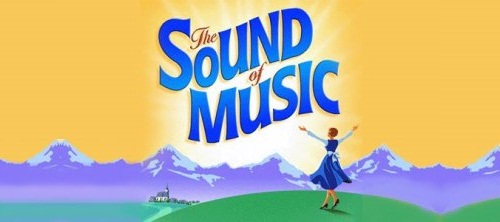Pas de biographie disponible.
Compositeur Musique additionelle Librettiste Parolier Metteur en scène Chorégraphe Producteur création Producteur version
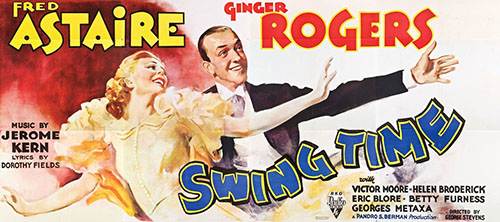
Film
Musique: Jerome Kern • Paroles: Dorothy Fields • Livret: Allan Scott • Howard Lindsay • Production originale: 1 version mentionnée
Dispo: Résumé
Le film préféré de Ginger Rogers avec Fred Astaire. Il s'agit du sixième - sur dix - partenariat de danse entre Fred Astaire et Ginger Rogers.
Genèse:
Résumé: Pour protéger sa carrière de danseur, les amis de John « Lucky » Garnett (Fred Astaire) l'empèchent de se marier avec Margaret Watson (Betty Furness) en lui volant son pantalon. Arrivé à son mariage après que les invités sont rentrés chez eux, il parvient à se réconcilier avec son futur beau-père, le juge Watson (Landers Stevens), à condition qu'il aille à New York faire fortune et ne revienne qu'avec 25 000 $. Accompagné de Edwin « Pop » Cardetti (Victor Moore), il se rend donc à New York, sans un sou en poche (il avait parié qu'il parviendrait à se marier). Il fait la rencontre de Penelope « Penny » Carroll (Ginger Rogers), qui enseigne la danse. Pour la conquérir, il joue et gagne jusqu'au moment où il approche de la somme fatidique…
Création: 4/9/1936 - *** Film (***) - représ.
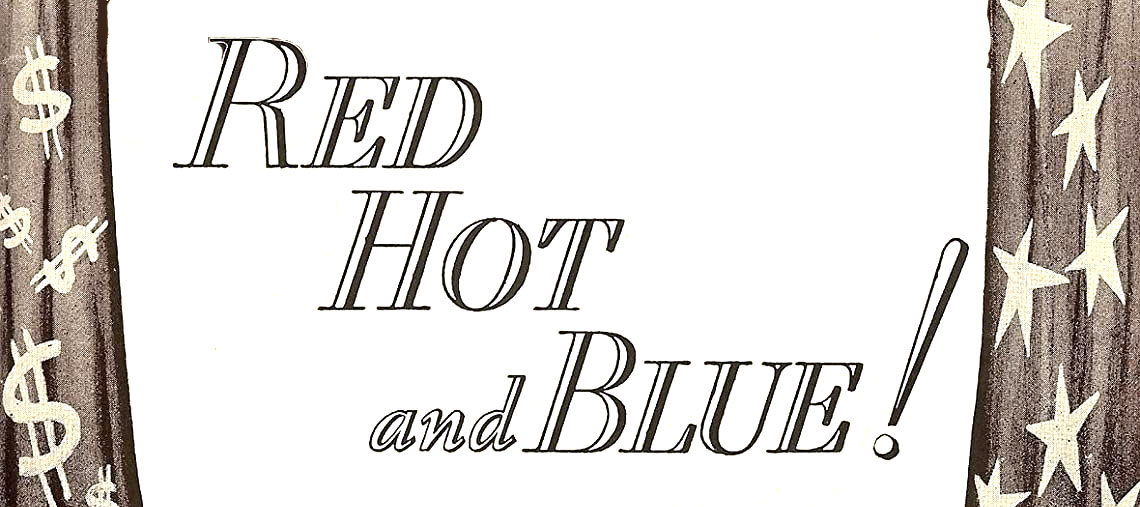
Musical
Musique: Cole Porter • Paroles: Cole Porter • Livret: Howard Lindsay • Russel Crouse • Production originale: 1 version mentionnée
Dispo: Résumé Commentaire Génèse Liste chansons
Red, Hot and Blue is a stage musical with music and lyrics by Cole Porter and a book by Howard Lindsay and Russel Crouse. It premiered on Broadway in 1936 and introduced the popular song "It's De-Lovely," sung by Ethel Merman and Bob Hope.
Genèse: History During the out-of-town tryouts, according to Cole Porter's biography, Cole Porter: A Biography by Charles Schwartz, the book was too long and did not blend with the music. Further the producer Vinton Freedley made "numerous suggestions for overhauling the show", which were accepted by all except Porter. Porter initially told Freedley to communicate through his agent, but finally relented. Additional conflict had arisen before the show's tryouts, when Freedley had assembled the cast and creative team behind the musical Anything Goes, hoping to repeat that show's success. William Gaxton was part of that cast, but withdrew because Ethel Merman's part was so large and Bob Hope was cast. The next conflict came over billing for Jimmy Durante and Merman, which was resolved by having their names crisscrossed above the title. The musical was first titled But Millions! and then Wait for Baby!. Porter had written the song "It's De-Lovely" for the film Born to Dance but it was not used. He turned it into a romantic duet for Merman and Bob Hope, in which they trace their romance from first kiss to marriage to a baby. Productions Red, Hot and Blue had its pre-Broadway tryout in Boston at the Colonial Theatre, starting on October 7, 1936, and the Shubert Theatre in New Haven starting on October 19, 1936. The musical premiered on Broadway on October 29, 1936 at the Alvin Theatre (now the Neil Simon Theatre) and closed on April 10, 1937 after 183 performances. Directed by Howard Lindsay with choreography by George Hale, it starred Ethel Merman as Nails O'Reilly Duquesne, Jimmy Durante as Policy Pinkle, and Bob Hope as Bob Hale. The Equity Library Theater (New York City) production ran in January 1984. The "Discovering Lost Musicals Charitable Trust" series staged the show at Barbican Centre Cinema 1 in 1994, with a cast that included Louise Gold and Don Fellows. Goodspeed Opera House in East Haddam, Connecticut mounted a revival in the fall of 2000 featuring a revised book by director Michael Leeds. The production starred Debbie Gravitte (Tony Award winner for "Jerome Robbins' Broadway") as Nails Duquesne, Peter Reardon as Bob Hale, and Ben Lipitz as Policy Pinkle. Previews began October 13 with the official opening on November 3. The production ran through December 31. Along with Leeds, the creative team included Andy Blankenbuehler (choreographer), Michael O'Flaherty (musical director), Ken Foy (sets), Ann Hould-Ward (costumes), and Ken Billington (lighting). The rest of the cast included Brian Barry (Rats), Robin Baxter (Peaches), Lesley Blumenthal, Randy Bobish (Bugs), Dianna Bush (Olive), Paul Carlin, Kevin Covert (Leonard), Beth Glover, Billy Hartung (Fingers), Jessica Kostival (Grace), Stephanie Kurtzuba (Jane), Kristin Maloney (Helen), Steve Luker (Eagle Eye), Jody Madaras, Trish Reidy (Vivian), Vince Trani, Matt Williams (Coyote), and Darlene Wilson (Barbara). A production in 2009 by George Productions had Richard Steven Horvitz as Policy Pinkle, Allyson Turner as Nails and Kyle Nudo as Bob Hale.
Résumé: Nails O'Reilly Duquesne is a newly wealthy young widow. Loud and brassy, Nails is a former manicurist. She organizes a benefit for her favorite cause, the rehabilitation of ex-convicts. Together with her sidekick (an "ex-con" himself), Policy Pinkle, and her "square" boyfriend, lawyer Bob Hale, she embarks on a nationwide search for Bob's old girlfriend, which is really the reason for the enterprise. The girlfriend, 18 years earlier, had sat upon a hot waffle iron and so had a unique "imprint". However, the national lottery that Nails starts gets the attention of the Finance Committee, and they wind up in Washington DC in an even more complicated situation. The Supreme Court declares the lottery unconstitutional, because it would benefit the people.
Création: 29/10/1936 - Neil Simon Theatre (Broadway) - 183 représ.
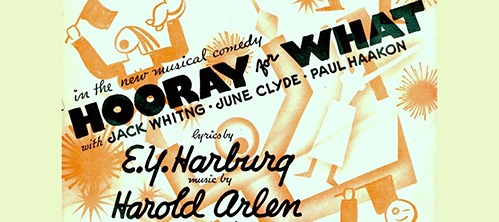
Musical
Musique: Harold Arlen • Paroles: E.Y. Harburg • Livret: Howard Lindsay • Russel Crouse • Production originale: 1 version mentionnée
Dispo: Résumé Génèse Liste chansons
Hooray for What! is an anti-war musical with music by Harold Arlen, lyrics by E. Y. Harburg and a book by Howard Lindsay and Russel Crouse. It introduced the song "Down With Love".
Genèse: The original Broadway production opened at the Winter Garden Theatre on December 1, 1937, and ran for 200 performances. Directors were Vincente Minnelli and Howard Lindsay, and choreographers were Robert Alton and Agnes de Mille (her first Broadway choreography). The cast featured Ed Wynn as Chuckles, Jack Whiting as Breezy Cunningham, Paul Haakon (Principal Dancer), June Clyde as Annabel Lewis (replacing Hannah Williams),[4] Vivian Vance as Stephanie Stephanovich (replacing Kay Thompson), Hugh Martin (Singing Ensemble), Ralph Blane as A Spy, and Meg Mundy (Singing Ensemble). Martin also did the vocal arrangements. Life Magazine called it "the funniest show of the year." 42nd Street Moon Theatre Company, San Francisco, California, presented the musical in a staged concert, in November 2004. It was presented by "The Medicine Show", New York City, in 2008.
Résumé: In Sprinkle, Indiana, Chuckles, a chemist, accidentally discovers a poisonous gas that could dominate the world. Breezy Cunningham is a weapons manufacturer, and tries to get the formula; when Chuckles refuses, Breezy hires the famous and alluring spy Stephanie Stephanovich to tempt it from Chuckles. Chuckles does not give in to Stephanie's wiles but goes to the League of Nations Peace Conference in Geneva to try to sell his discovery, which has somehow turned into a "love" potion. Meanwhile, Breezy, Stephanie, and their cohorts try to obtain the formula for the poisonous gas.
Création: 1/12/1937 - Winter Garden Theatre (Broadway) - 200 représ.
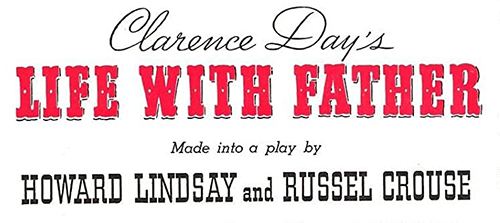
Théâtre
Musique: Paroles: Livret: Howard Lindsay • Russel Crouse • Production originale: 1 version mentionnée
Dispo: Résumé Commentaire Génèse
Life with Father is a 1939 play by Howard Lindsay and Russel Crouse, adapted from a humorous autobiographical book of stories compiled in 1935 by Clarence Day. The Broadway production ran for 3,224 performances over 401 weeks to become the longest-running non-musical play on Broadway, a record that it still holds. The play was adapted into a 1947 feature film and a television series.
Genèse: The 1939 Broadway production ran for over seven years to become the longest-running non-musical play on Broadway, a record that it still holds. It also held the title of the longest running Broadway play of any type of all time from 1947 to 1972. It opened at the Empire Theatre on November 8, 1939 and ran at that theatre until September 8, 1945. It then moved to the Bijou Theatre where it ran until June 15, 1947, and finished its run at the Alvin Theatre on July 12, 1947, for a combined total of 3,224 performances. The play was produced by Oscar Serlin, staged by Bretaigne Windust, with setting and costumes by Stewart Chaney. It starred Howard Lindsay, his wife Dorothy Stickney, and Teresa Wright. Subsequent productions Concurrent with the Broadway production, the producers sent out 11 touring companies that performed in 214 cities.[6] The amateur rights to Life with Father were released in 1948, and the following year saw 187 productions of the play, including a production at Theatre in the Round Players that included consultation with Warner films on staging. In 1953, The Ford 50th Anniversary Show, broadcast live on both the CBS and NBC television networks, opened with Oscar Hammerstein II introducing a scene from the play featuring original cast members, Howard Lindsay and Dorothy Stickney. The Ford show attracted an audience of 60 million viewers. Forty years after the broadcast, television critic Tom Shales recalled the broadcast as both "a landmark in television" and "a milestone in the cultural life of the '50s". The only major New York revival occurred in 1967 in a limited run at City Center, starring Leon Ames and Dorothy Stickney. Critic Vincent Canby called the revival "a quaint, pretty picture postcard."[10] Although professional revivals are now rare, Life with Father continues to be produced by amateur companies such as the American Century Theatre in Virginia (2009) and the Victorian Players in Ohio (2014).
Résumé: Clarence Day wrote humorously about his family and life. The stories of his father, Clarence "Clare" Day, Senior, were first printed in The New Yorker. They portray a rambunctious, overburdened Wall Street broker who demands that everything from his family should be just so. The more he rails against his staff, his cook, his wife, his horse, salesmen, holidays, his children and the inability of the world to live up to his impossible standards, the more comical and lovable he becomes to his own family who love him despite it all. First published in 1936, shortly after his death, Day's book is a picture of New York upper-middle-class family life in the 1890s. The stories are filled with affectionate irony. Day's understated, matter-of-fact style underlines the comedy in everyday situations.
Création: 8/11/1939 - Empire Theatre (Broadway) - représ.
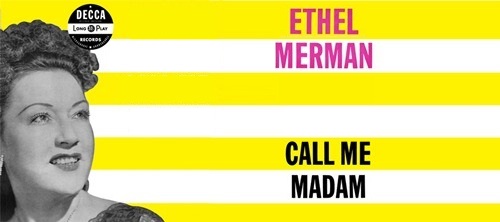
Musical
Musique: Irving Berlin • Paroles: Irving Berlin • Livret: Howard Lindsay • Russel Crouse • Production originale: 10 versions mentionnées
Dispo: Résumé Synopsis Génèse Liste chansons
Genèse: The lead character is based on Washington, D.C. hostess and Democratic Party fundraiser Perle Mesta, who was appointed the Ambassador to Luxembourg in 1949. The Playbill distributed at each performance humorously noted that "neither the character of Mrs. Sally Adams nor Miss Ethel Merman resemble any person living or dead." In 1949, Merman and her family were vacationing at the Hotel Colorado in Glenwood Springs with Howard Lindsay and his wife Dorothy Stickney. Watching Merman poolside while reading a magazine article about Mesta, Lindsay was struck by how typically "American" she was and immediately envisioned her portraying a colorful character similar to the newly appointed ambassador. When he proposed the idea to Merman, who had little interest in either society or political news, she responded, "Who's Perle Mesta?" Although Merman had announced she was interested in playing a dramatic role in her next project, Lindsay and Russel Crouse approached Irving Berlin and began working on the book for Call Me Madam when he expressed interest in composing the score. Berlin's last production, Miss Liberty, had failed to recoup its investment, and he was determined to repeat the success he had had with Annie Get Your Gun. The three collaborators agreed they needed to treat their subject with care to avoid any legal action by Mesta. As the work progressed, Merman conceded she would be willing to sing two or three songs, but eventually accepted the fact she was going to star in a full-scale musical comedy instead of the drama she preferred. Producer Leland Hayward budgeted the production at $250,000. In exchange for the original cast recording and television broadcast rights, he arranged to have it financed 100% by RCA Records and NBC, with the two sharing 35% of the net earnings. In order to increase the profits, Hayward decided to charge an all-time high of $7.20 for orchestra seats. Hayward hired George Abbott to direct, and Abbott and casting director Harold Prince auditioned thousands of actors for the twenty speaking roles and twenty-nine chorus members. Raoul Pene du Bois was hired to design sets and costumes, although the wardrobe worn by Merman was the responsibility of Mainbocher. Once the script was completed, everyone agreed that while it was little more than standard situation comedy material it was a perfect vehicle for Merman, and that Berlin's score, although far from his best, was tuneful and memorable. It included the comic song "Mr. Monotony", which originally was written for and dropped from the film Easter Parade. Berlin had then included it in Miss Liberty, but it was dropped from that as well. In this instance, the third time was not the charm; during out-of-town tryouts, Merman insisted it be dropped. (In 1989, Sarah Brightman recorded it for her CD The Songs That Got Away.) To fill the hole its omission left in the second act, Berlin wrote "Something to Dance About" to give the second act a lively opening. When the star requested a duet with Russell Nype playing her lovestruck press attache Berlin responded by writing the counterpoint tune "You're Just in Love" and it ultimately became a showstopper at every performance. Directed by George Abbott and choreographed by Jerome Robbins, the musical premiered at the Shubert Theatre in New Haven, Connecticut on September 11, 1950. Reviews were mixed - Variety said it "inspires warm applause rather than cheer"—and Berlin wrote two new songs to bolster the sagging second act. It opened in Boston on September 19, and while The Boston Record thought it offered "only an occasional flash of inspirational fire", it played to standing-room-only audiences throughout the run. With a record advance sale of $2 million, the Broadway production opened on October 12 at the Imperial Theatre, where it ran for 644 performances and grossed more than $4 million. In addition to Merman and Nype, the cast included Paul Lukas, Pat Harrington, Sr., Lilia Skala, and Richard Eastham. Brooks Atkinson of The New York Times thought it offered one of Berlin's "most enchanting scores: fresh, light, and beguiling, and fitted to lyrics that fall out of it with grace and humor", and the New York Post called Merman "indescribably soul-satisfying", "a comedienne of rare skill", and "one of the joys of the world." She remained with the show for the entire run and appeared in the limited four-week engagement staged to celebrate the reopening of the National Theatre in Washington, D.C., but her understudy Elaine Stritch starred in the national tour. The musical opened in the West End at the London Coliseum on March 15, 1952 where it ran for 486 performances and starred Billie Worth. The New York City Center Encores! semi-staged concert version starring Tyne Daly was presented in February 1995.[3] A regional production ran at the Paper Mill Playhouse, Millburn, New Jersey, in April–May 1996 and starred Leslie Uggams.
Résumé: Sally Adams becomes Ambassador of Lichtenburg and charms Cosmo Constanstine with her undiplomatic manner. Meanwhile, her press attache, Keneth Gibson, falls in love with Princess Maria.
Création: 12/10/1950 - Imperial Theatre (Broadway) - représ.
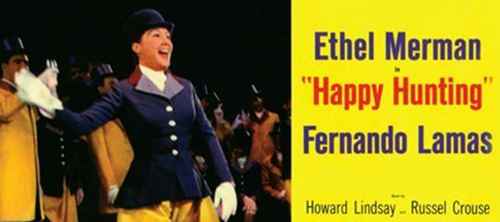
Musical
Musique: Harold Karr • Paroles: Matt Dubay • Livret: Howard Lindsay • Russel Crouse • Production originale: 1 version mentionnée
Dispo: Résumé Génèse Liste chansons
Happy Hunting is a 1956 musical with a book by Howard Lindsay and Russel Crouse, lyrics by Matt Dubey, music by Harold Karr, original choreography by Alex Romero, assistant choreographer Eugene Louis Faccuito (Luigi) . The plot focuses on wealthy Philadelphia Main Line widow Liz Livingstone and her efforts to find a royal husband for her daughter Beth.
Genèse: Background After marrying her third husband, Continental Airlines executive Robert Six, in 1953, Ethel Merman retired from performing and happily embraced the life of a Colorado housewife. Six, however, had expected her public appearances to engender publicity for the airline, and her decision to forego the limelight did not sit well with him. He urged her to accept the lead in Happy Hunting, with a book by Howard Lindsay and Russel Crouse (who had written Call Me Madam) and a score by the unknown team of Harold Karr and Matt Dubey. Merman thought the songs were weak but grudgingly acquiesced to her husband's demands. Initially Merman was pleased with co-star Fernando Lamas, but soon after rehearsals began they clashed when he publicly criticized her performance, and as tensions between them escalated they stopped speaking to each other. Lamas was certain he would be overshadowed by Merman and plotted to draw the focus away from her. Known throughout Hollywood for his unusually large physical endowment, he instructed costume designer Irene Sharaff to cut his pants so they would cling as tightly as possible. On opening night in Philadelphia during the pre-Broadway tryout, his appearance elicited loud gasps from the audience when he stepped out on stage for the first time. Merman was not amused by the vulgar display and demanded his costume be altered. Throughout the tryout period, Merman expressed her dissatisfaction with both the book and the score, both of which underwent revisions on a regular basis. After the show opened on Broadway, she insisted two of her least favorite numbers be replaced by songs written by her friend Roger Edens who, due to his exclusive contract with Metro-Goldwyn-Mayer, credited them to Kay Thompson. Production Directed by Abe Burrows, with musical staging by Alex Romero and Bob Herget, the Broadway production opened with an advance sale of $1.5 million on December 6, 1956 at the Majestic Theatre, where it ran for 412 performances. It closed on November 30, 1957, with Merman happy to see what she considered "a dreary obligation" finally come to an end. In addition to Merman and Lamas, the cast included Virginia Gibson as Beth Livingstone, Gordon Polk as Sandy Stewart, Leon Belasco as Arturo, and Estelle Parsons in her Broadway debut. Jo Mielziner was responsible for the scenic and lighting design.
Résumé: Liz Livingstone and her daughter Beth arrive in Monaco to attend the wedding of Prince Rainier and fellow Philadelphian Grace Kelly, only to be denied admission when her name cannot be found on the guest list. To save face, Liz pretends her hotel suite was robbed and she had nothing suitable to wear to the ceremony. Angered by the snub and determined to find her daughter an even better husband than Grace, Liz arranges a date for Beth and the Duke of Grenada, unaware that the hotel's financial problems, which are being investigated by her attorney Sandy Stewart, are due in no small part to the Duke's failure to pay his bills. When she is made aware of the situation, Liz offers to settle his account and move him, his assistant Arturo, and his prized horses to Philadelphia if he will marry Beth, and he agrees to accept her offer. Back in the States, complications arise when Liz finds herself falling in love with the Duke while Beth finds she is attracted to Sandy. Everything is resolved when Beth and Sandy elope and the Duke agrees to marry Liz, who realizes he loves her for her money but is willing to accept him on those terms.
Création: 6/12/1956 - Majestic Theatre (Broadway) - 412 représ.
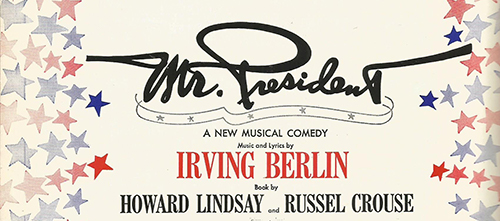
Musical
Musique: Irving Berlin • Paroles: Irving Berlin • Livret: Howard Lindsay • Russel Crouse • Production originale: 1 version mentionnée
Dispo: Résumé Commentaire Génèse Liste chansons
Mr. President is a musical with a book by Howard Lindsay and Russel Crouse and music and lyrics by Irving Berlin. The story focuses on fictional US President Stephen Decatur Henderson, who runs into political trouble following a disastrous trip to the Soviet Union and his problems with his children. Bored with life as a civilian after his presidency ends, he decides to return to political life.
Genèse: The musical had its first out-of-town tryout in Boston beginning on August 27, 1962 and was coolly received. After extensive cuts and revisions, it was given another tryout at the National Theatre in Washington, DC, on September 25, 1962 which was attended by President John F. Kennedy and First Lady Jacqueline Kennedy. The first couple congratulated Berlin on a hit. Kennedy later sent his aides, Kenneth P. O'Donnell and David Powers, to apologize to Berlin for his having to leave the performance early. This day of Kennedy's presidency is the one featured in an exhibit at the JFK Museum and Library. The Washington reviews "were lukewarm and even negative. The word 'corny' stuck, and was repeated again and again." After four previews, the Broadway production, directed by Joshua Logan and choreographed by Peter Gennaro, opened on October 20, 1962 at the St. James Theatre, where it ran for 265 performances. The cast included Robert Ryan, Nanette Fabray, Anita Gillette and Baayork Lee. The musical premiered in a Broadway season dominated by hits like Oliver!, A Funny Thing Happened on the Way to the Forum and Stop the World – I Want to Get Off. Mr. President received unenthusiastic reviews. Although Berlin's score was praised, the show "was just too old-fashioned and out of date." Berlin continued to work, revising Annie Get Your Gun and writing songs, such as for the film project Say It With Music (which was never produced), but "Broadway would never again see a truly Berlin work on the stage". Mr. President was the final Lindsay and Crouse collaboration. In 1964, former President Harry S. Truman made an opening night cameo appearance in a production of the show at the Starlight Theatre in Kansas City. He left by ambulance at intermission due to an appendicitis attack. Gerard Alessandrini extensively revised the book and converted the plot into a spoof of the 2000 Presidential election debacle. After thirty previews, it opened on August 2, 2001 at the Off-Broadway Douglas Fairbanks Theater where, hampered by reviews worse than those received by the original, it closed after only ten performances. Ben Brantley, in his review for The New York Times, wrote that the musical "feels tired". However, the TheatreMania reviewers noted that, while "the overall tenor of the satire here is soft," it has "surprisingly buoyant appeal. It remains bubbly and effervescent thanks to the peppy, imaginative direction supplied by the team of John Znidarsic and Alessandrini."
Résumé: President Stephen Decatur Henderson is a true patriot and loves his family. His daughter Leslie has recently had a series of romantic liaisons, some liberal and some conservative. Her newest romance is with Youssein Davair, the son of a Middle Eastern ruler; the sincerity of his affection is questionable. Pat Gregory, a Secret Service agent, has watched Leslie grow up and has fallen in love with her but doesn't believe that she could be interested in a simple guy like him. With the Cold War as a backdrop, Henderson, together with Nell, his First Lady, and their children go on a "good-will tour" of Europe, including the Soviet Union. Henderson gets in trouble for jokingly comparing the Soviet leader to a "wild cat". But the President lands in Moscow anyhow and gives a conciliatory and humanizing speech, assisted by his Russian-speaking son Larry, that earns the respect of the Soviets. Nevertheless, back at home, the gaffe plagues him and hurts his party's popularity. Larry is a bit of a hot-head and punches the party chairman on TV to defend his father. The presidential term of office ends, and the Hendersons leave the White House. In Act II, Henderson finds his post-politics life in Ohio mundane. The family is invited to a party at the White House, and there Leslie finds that Youssein is now interested in Betty Chandler, the daughter of the new President, and so they break up. Leslie leaves the party with Pat. Meanwhile, one of Ohio's senators dies, and the governor asks Henderson to finish his term of office. Henderson yearns to return to public life, but he questions the governor's motives and declines the job. Soon afterwards, however, another opportunity comes: the new President asks Henderson to attend an international summit meeting on behalf of the US, because of the respect that he commands in the Soviet Union.
Création: 20/10/1962 - St. James Theatre (Broadway) - 265 représ.
